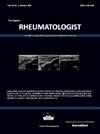The role of fibrinogen to albumin ratio in patients with systemic lupus erythematosus: Relation with disease characteristics
IF 1
Q4 RHEUMATOLOGY
引用次数: 0
Abstract
Aim of the work
to investigate the role of fibrinogen to albumin ratio (FAR) in systemic lupus erythematosus (SLE) patients and its relationship with disease characteristics.
Patients and methods
This study included 45 SLE patients with activity and another 45 without as well as 45 controls. The clinical, laboratory data including FAR measurement and SLE disease activity index 2000 (SLEDAI-2K) were assessed.
Results
The patients were 83.3% females, with a median (IQR) age of 30.5 (23–41) years and disease duration of 4 (2–7) years. The median FAR value was significantly higher in patients (1.4, 0.6–1.8) compared to control (0.6, 0.5–0.8) and in active (1.6, 1.2–2.1) compared to inactive (0.7, 0.5–1.7) patients (both p< 0.0001). Higher FAR values were significantly associated with receiving disease modifying antirheumatic drugs (DMARDs) (n= 82) (1.4, 0.7–2 vs 0.4, 0.15–1.1) (p= 0.01). FAR significantly correlated with the erythrocyte sedimentation rate (ESR) (r= 0.3, p= 0.004), anti-double stranded deoxyribonucleic acid (anti-dsDNA) (r= 0.28, p= 0.008) and urinary protein/creatinine (r= 0.48, p< 0.0001) while inversely with complement (C3: r= -0.41, p< 0.0001 and C4: r= -0.31, p= 0.003). Anti-dsDNA was the most significant factor affecting the values of FAR (β= 0.24, p= 0.04). The best cut-off value of FAR to discriminate SLE from controls and active from inactive patients were 1.1 and 0.8, with a diagnostic sensitivity of 58.9% and 86.7% and specificity of 95.6% and 55.6%, p< 0001 and p< 0.001, respectively.
Conclusion
The FAR was significantly increased in SLE patients and was linked with disease activity particularly renal. FAR can be used as an inflammatory biomarker to monitor SLE disease activity.
纤维蛋白原与白蛋白比在系统性红斑狼疮患者中的作用:与疾病特征的关系
目的探讨纤维蛋白原与白蛋白比(FAR)在系统性红斑狼疮(SLE)患者中的作用及其与疾病特征的关系。患者和方法本研究包括45例活动期SLE患者、45例活动期SLE患者和45例对照组。评估临床、实验室数据,包括FAR测量和SLE疾病活动性指数2000 (SLEDAI-2K)。结果患者中女性占83.3%,中位(IQR)年龄30.5(23-41)岁,病程4(2-7)年。患者的FAR中值(1.4,0.6 - 1.8)显著高于对照组(0.6,0.5-0.8),运动患者(1.6,1.2-2.1)显著高于不运动患者(0.7,0.5-1.7)(均为p<;0.0001)。较高的FAR值与接受改善疾病的抗风湿药物(DMARDs)显著相关(n= 82) (1.4, 0.7-2 vs 0.4, 0.15-1.1) (p= 0.01)。FAR与红细胞沉降率(ESR) (r= 0.3, p= 0.004)、抗双链脱氧核糖核酸(anti-dsDNA) (r= 0.28, p= 0.008)、尿蛋白/肌酐(r= 0.48, p= lt;(C3: r= -0.41, p<;0.0001和C4: r= -0.31, p= 0.003)。抗dsdna是影响FAR值最显著的因素(β= 0.24, p= 0.04)。FAR区分SLE与对照组、活动期患者与非活动期患者的最佳临界值分别为1.1和0.8,诊断敏感性分别为58.9%和86.7%,特异性分别为95.6%和55.6%;0001和p<;0.001,分别。结论SLE患者FAR显著增高,且与疾病活动性(尤其是肾脏)有关。FAR可作为监测SLE疾病活动性的炎症生物标志物。
本文章由计算机程序翻译,如有差异,请以英文原文为准。
求助全文
约1分钟内获得全文
求助全文

 求助内容:
求助内容: 应助结果提醒方式:
应助结果提醒方式:


